Did you know the global legume market was valued at $7.52 billion in 2021 and is expected to hit a whopping $17.25 billion by 2030? It’s not surprising that the demand for these nutrient-dense foods is soaring. Besides handy nutrients like carbohydrates, fiber, and vitamins, they’re also amazingly pocket-friendly.
Moreover, you don’t have to get your legumes from the local store because you can quickly grow them in your garden, on the ground, or in pots. One of the best months to sow the seeds is June—the soil and air temperatures are high, so they’re off to a good start. If you’re an avid gardener or looking to start your own vegetable garden, planting legumes in June can be rewarding. Legumes are nutritious and beneficial for the soil as they fix nitrogen, enriching it for other plants.
Which are the best legumes to plant in June? Well, this article divulges your seven best options. We’ll also give you a few practical tips to grow these fast-growing plants and guarantee a big harvest.
Bush Beans
Bush beans, or snap beans, are green beans that typically grow on short, bushy plants. They’re perfect for June planting once the frost has passed. Usually, they flourish in the full sun, in well-drained, slightly acidic, or neutral soil with a pH of 6.0 to 6.8. Therefore, apply some lime before sowing your seeds if your garden soil’s pH is below that. We also recommend enriching the ground to avoid the hassle of fertilizing it later.
Like most legumes, bush beans proliferate. They start sprouting as little as six days after sowing and mature within 50 to 60 days. Water these plants early in the day, giving their leaves plenty of time to dry before night. 2-3 inches of water are ideal weekly to promote fast, healthy growth.
Listed below are some of the best bush bean varieties to plant in June:
Maxibel
Dark green, straight, and high quality, the Maxibel is among the first full-size (7-inch pods) bush filet beans to appear on the market. Hand-picking is its best harvesting method, and once cooked, it boasts an unmatched bean flavor.
Nickel
Another bush bean variety suitable for June planting is the stringless Nickel, whose pods grow up to 4 inches long. Like the Maxibel, it’s known for its great taste. But that’s not its only appealing aspect. Ideally, this type of bush bean is white mold resistant and doesn’t develop brown spots.
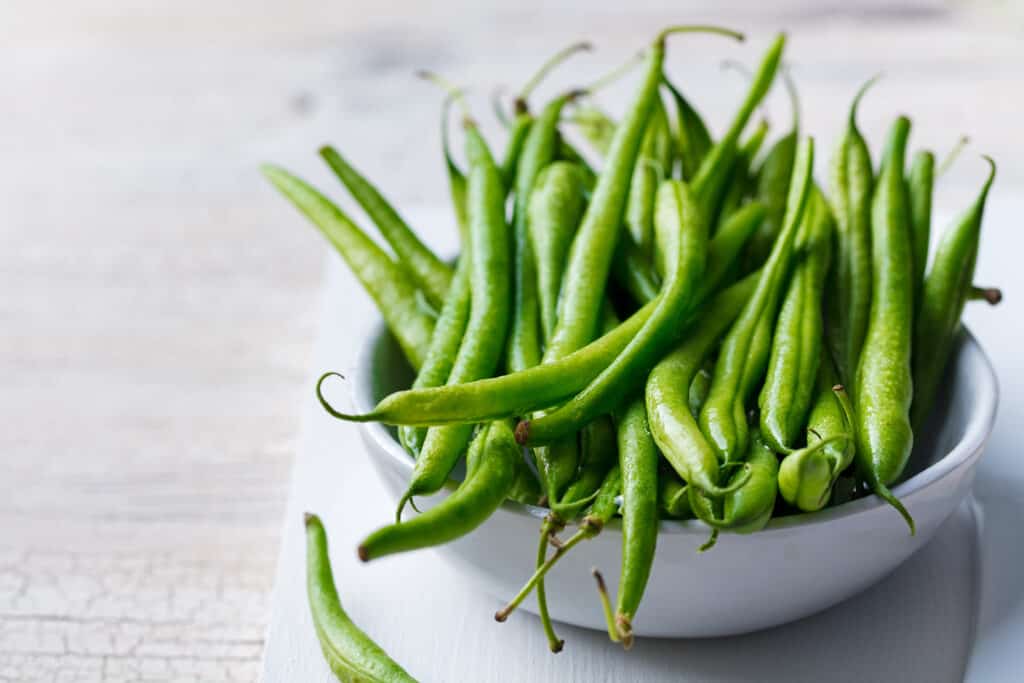
The variety of bush beans makes them perfect for June planting.
©Anna_Pustynnikova/Shutterstock.com
Dragon Tongue
Here’s a delicious, stringless, prized Dutch wax heirloom that merits your time and effort if you’re looking for a bush bean variety to plant in June and harvest in only 55 days. You can eat these legumes raw or cooked, depending on your preference. We recommend gathering them early while they’re still small if you intend to avoid cooking them.
Dragon tongue bush beans are known for their pods’ distinct yellow shade with purple stripes. Additionally, they’re long (can grow up to eight inches) and flat. The plants can reach 30 inches tall upon maturity and require well-drained, slightly acidic soil to thrive.
Jade
It’s common to find legume lovers planting the jade bush bean, and it’s all for a good reason. For starters, this classic cultivar boasts excellent quality. In addition, it comes with long, slender, dark jade-green pods that are super delicious once cooked.
Contender
Another bush bean cultivar you should give a chance is the contender. These beans’ main selling point is their thick, soft ponds that are palatable, whether fresh or frozen. Moreover, they’re resistant to the bean mosaic virus, mildew-tolerant, and produce large yields.
Unlike many other cultivars, contender bush beans can take up to 70 days to reach maturity. Even so, if you plant them in early June, a fall crop is guaranteed.
Pole Beans
Pole beans are another type of green bean convenient for June planting. They grow as climbing vines that reach up to 15 inches in height, requiring support weeks after sowing.
Many commercial growers and home gardeners prefer pole beans to bush beans because they are starchier and tastier, bringing in more returns. Besides, these legumes provide a longer harvest window. They can easily be harvested while standing—potentially saving you from hours of back ache.
But, regrettably, enjoying these benefits comes at a price. For starters, sowing and growing pole beans is more demanding than growing bush beans because you must construct a trellis system. The latter is time-consuming and expensive, especially if you’re a large-scale farmer.
Nevertheless, here are some widely preferred pole bean varieties to consider:
- Blue coco
- Fortex
- Monte Gusto
- Ideal market
- Orient wonder
- Snow on the Mountain
- Qing Bain
- Yellow Bai Bu Lao

Pole beans are an excellent choice for your garden this June as they provide more returns compared to bush beans.
©iStock.com/eurobanks
Snap Peas
The primary sowing season for snap peas is from mid-March to June. You can plant them in your garden, but if your space is limited, containers will do. Either way, you’ll enjoy their sweet flavor upon harvesting them after 42 to 56 days. We recommend doing it while their pods are still green and tender since that’s when the peas inside begin to swell.
Snap peas don’t grow in cold weather. In fact, they barely germinate without a soil temperature of 50ºF (10ºC), so you might have to warm your planting patch before sowing. You can cover the area with a plastic sheet or tunnel. If you want the best harvest after planting your sugar snap peas, utilize the following tips throughout the growing season.
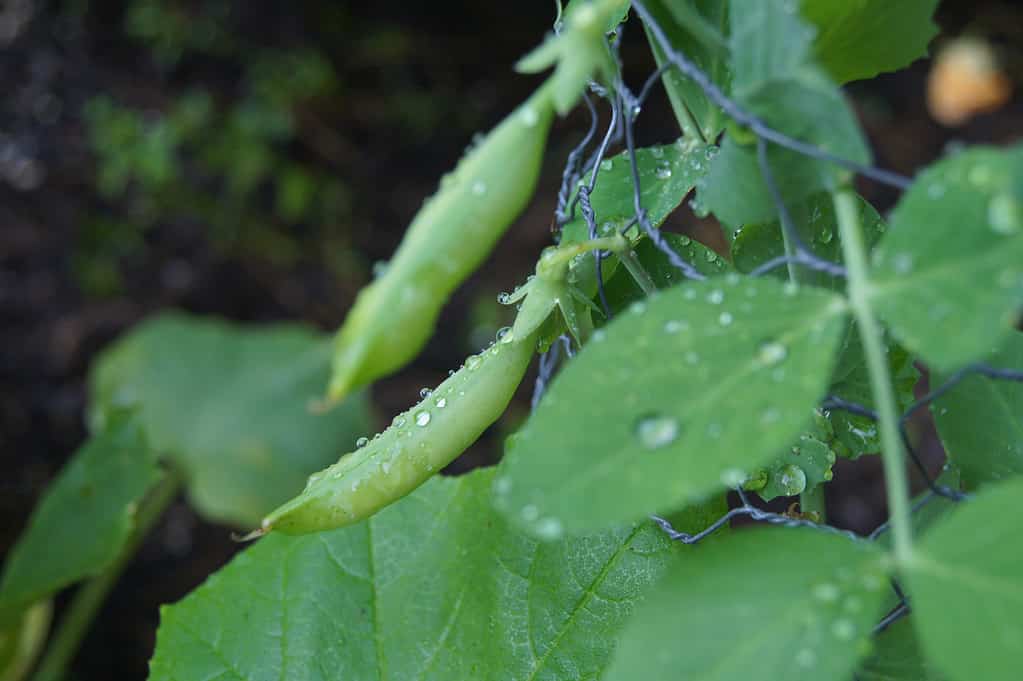
With their delicate pods and refreshing flavor, snap peas are a perfect addition to your legume collection.
©iStock.com/PierceHSmith
Plant Them in Sunny Spots
Like all legumes, snap peas are sun-loving plants. Hence, ensure they get plenty of it by planting them in patches that can access direct sunlight. You should also monitor the soil temperature regularly—it must remain between 40°F and 70°F. Should it drop below forty degrees, apply a thick mulch layer, preferably two inches, to prevent the plants from rotting.
Enrich the Soil
Typically, snap peas are nitrogen-fixing plants. However, they still get their nutrients from the soil, begging you to replenish it occasionally. We propose a high phosphorus fertilizer like 15-30-15 in their early growth and a little well-rotted manure during sowing.
Set a Trellis System
Snap peas are climbers, so they’ll need places to latch on during the growing period. It helps the plants grow vertically, makes them feel more secure, and produces many pods.
You’re spoiled for choice when setting up a trellis system for snap peas, as they tend to wrap around anything. Your options include the following:
- Strings
- Wire mesh
- Twines
- Trellis netting
Be sure to plant your sugar snap peas on both sides of the trellis system to enjoy the bountiful harvest you long for.
Garden Peas
Also known as English peas or sweet peas, the nutritious garden peas also made it to our list of the best legumes to plant in June. Interestingly, many people confuse them with sugar snap peas because they’re both round. But the truth is, the latter is a cross between English peas and snow peas, and their pods are usually smaller and thinner.
Like other peas, garden peas are vining species that demand support, meaning a trellis system is a must-have. Then, we recommend protecting them against the hot sun and monitoring their soil moisture in warm weather. The best temperature range for the legumes is 55°F to 65°F; anything above 80°F translates into a poor harvest.
Therefore, consider mulching to maintain the optimum soil temperature and protect them against strong winds to boost yields. You can do this by tying the new growth to a trellis system or taller plants. Adding more frames or sticks to the chicken wire or mesh also shields them from the damaging repercussions of harsh weather.
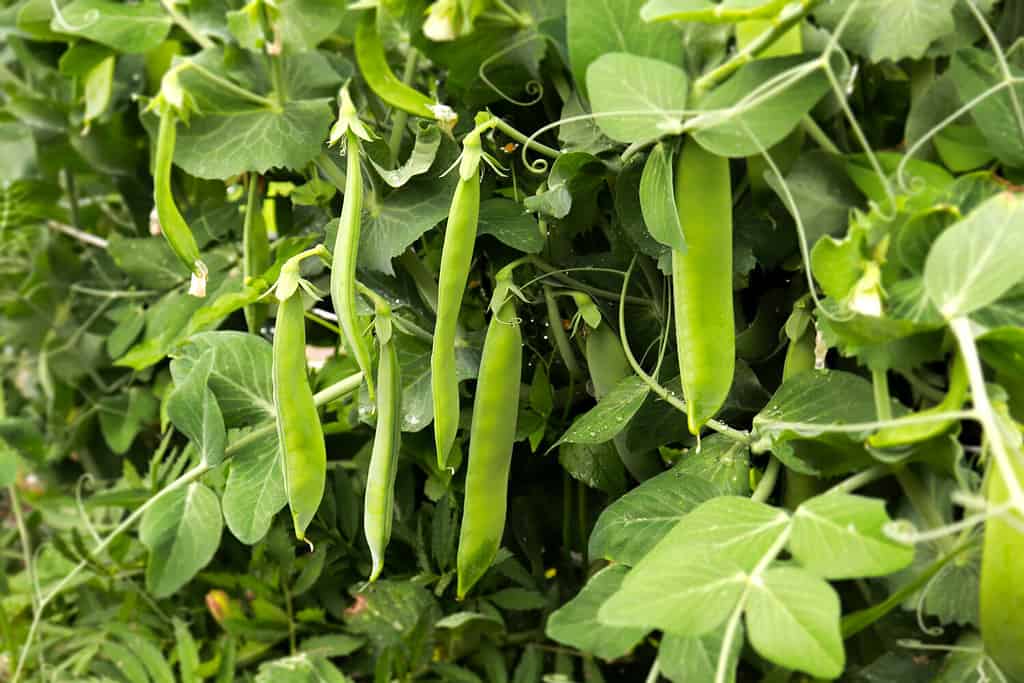
These versatile legumes require support and optimal temperatures for maximum output.
©Natallia Ustsinava/Shutterstock.com
Broad Beans
Rigid, stout-stemmed, and large, broad beans are reputed to be cool-season crops that you can sow anytime from late fall to early summer. In mild climates, these legumes germinate well between October and June. Because they’re frost hardy, they can easily survive cold temperatures. But if they’re too low, the plants might wait until spring to bloom or produce ponds.
If you’re planting broad beans in your outdoor garden, sow them in double rows, 9 inches apart. Be sure to scatter the seeds so they’ll have much space to grow, and ensure each is 2 inches into the soil. You can also plant these legumes in containers or module trays in a greenhouse or indoor garden. It lets you control the conditions and keep pests like slugs and mice at bay.
Practical Tips to Grow Broad Beans
Caring for your broad beans assures you of a great harvest. Be sure to generously water the plants during the flowering season. You should also monitor them regularly and remove any weeds growing around them.
On top of that, cut out the growing tips as soon as you notice the plants’ first flowers. That allows more pods to set and prevents blackflies, a common issue in the broad bean world. Even so, if it doesn’t work and the black bean aphids still attack your legumes, remove them by spraying a mixture of rosemary, peppermint, clove, and thyme on the infested specimens. Do this repeatedly during the rainy season for it to work.
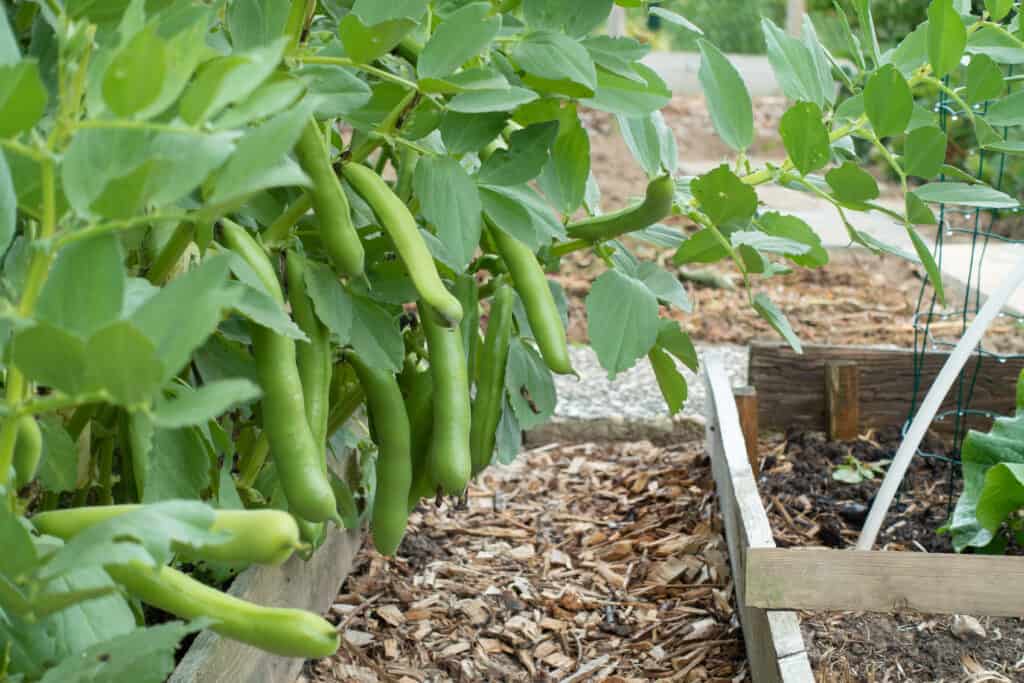
During flowering, be sure to water the plants generously.
©Ad van Brunschot/Shutterstock.com
Lima Beans
Lima beans are known for their mild, creamy flavor and are mainly planted between mid-May and mid-June in most parts of the world. Their ideal germination soil temperatures are 75°F to 85°F. Anything below 60°F leads to poor growth during the plants’ early stages, and saving them becomes nearly impossible.
There’s some good news, though. Sowing lima beans is a breeze, even for amateurs. Plant the seeds in rows roughly 2 feet apart, approximately 1 or 1.5 inches deep, in loamy, well-drained soil. They’ll germinate well with about half an inch of water weekly and more of it during the flowering period. Otherwise, the blossoms will drop prematurely, resulting in poor yields.
Lima beans are usually ready for harvest within 65 to 75 days after harvest.
Having them for lunch or dinner enables you to delight in these incredible benefits:
- Increased energy levels.
- Enhanced heart health.
- Better digestion.
- Improved blood circulation.
- Quicker recovery after an illness or physical injury.
- Improved blood sugar control
- Faster weight loss.
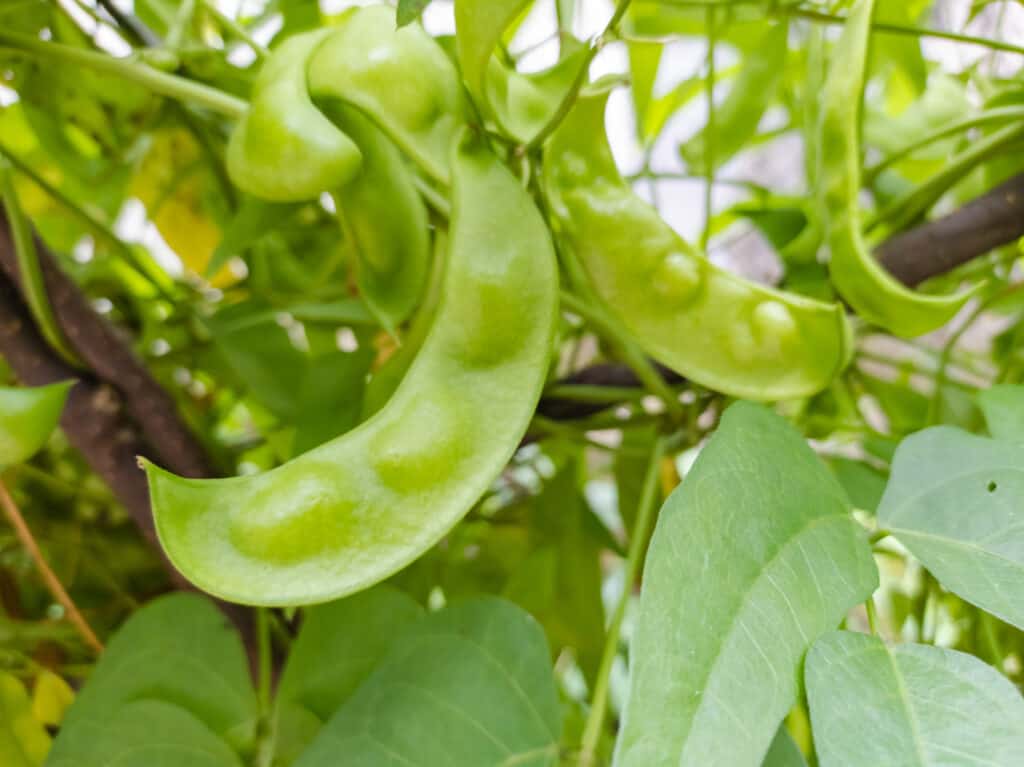
These versatile legumes thrive in warm weather and are easy to plant, even for beginner gardeners.
©Rulli Yulianto/Shutterstock.com
Peanuts
The planting season for peanuts in many regions is from April to late June, giving them ample time to get accustomed to the cool spring weather before the intense summer heat hits. The legumes usually germinate in soil temperatures between 68°F and 95°F and can be sown indoors and outdoors.
Caring for peanuts is essential if you want a big harvest. When the plants are roughly six inches tall, dig around them to loosen the soil so the pegs can penetrate it easily. We also endorse hilling them, like you would potatoes, and mulching them with grass clippings to help retain much-needed moisture and minimize erosion, which could lead to the loss of nutrient-rich soil.
Some peanut varieties take between 30 and 40 days to produce a bountiful harvest. However, other cultivars may take 130 to 160 days to mature. Nevertheless, the best time to harvest the legumes is when the plant yellows, just before frost.

Planting peanuts between April to late June ensures you get a bountiful harvest.
©iStock.com/Maryviolet
Sowing Legumes in June: Top Tips for Gardeners
Provide the Right Environment
All legumes like direct sunlight, so planting them in shaded areas is a big no-no. Sowing the seeds at least 6 to 13 inches apart is also a great idea to deter them from blocking each other from the sun, aiding healthy growth.
In addition, be sure to plant the legumes in fertile, well-drained soil to guarantee access to essential nutrients and prevent waterlogging.
Choose the Right Legumes
Did you know that different types of legumes adapt to varying climatic conditions? It would help if you only planted legume species in your garden or greenhouse after confirming they can flourish in your area. The quickest way to find out is to ask local growers who’ve been in the game longer than you; they might even offer you valuable tips for sowing your seeds.
As you hunt for the best legumes to plant in June, we recommend you steer clear of hybrid and GMO seeds. While the plants will grow faster, they don’t produce true legumes, although they might be tastier when cooked.

Ask local growers in your area what legumes work best in your area to ensure you get a bountiful harvest.
©iStock.com/Dinesh Ahir
Control Common Pests
Like most other plants, legumes are susceptible to pest attacks like aphids, flower thrips, white flies, and caterpillars. Please take the necessary measures to keep them at bay because they can ravage your plants before harvest. An effective way to do that is by removing weeds and clutter, as they provide places for dangerous species to breed and thrive.
Plant Your Legumes in June
These seven picks should be a priority if you’re hunting for the best legumes to plant in June. Growing any of them in your outdoor garden or greenhouse brings about a plethora of perks, such as improved soil quality. Moreover, you can always prepare them for lunch or dinner after harvest and pair them with salads, stews, pasta sauces, or soups.
Another reason you shouldn’t think twice about planting these legumes is they’re all easy to grow. Caring for them until harvest is a piece of cake, no matter your experience level. Of course, the daily hours and effort you dedicate to the plants will depend on the seeds you sow and the yields you hope for.
As expected, great produce calls for more devotion, as you’ll need to closely monitor your legumes to ensure they’re healthy and keep pests and diseases at arm’s length. So, get ready to reap the rewards of your hard work and savor the flavors of homegrown legumes straight from your summer garden. Happy planting!
The photo featured at the top of this post is © iStock.com/piyaset
Thank you for reading! Have some feedback for us? Contact the AZ Animals editorial team.







